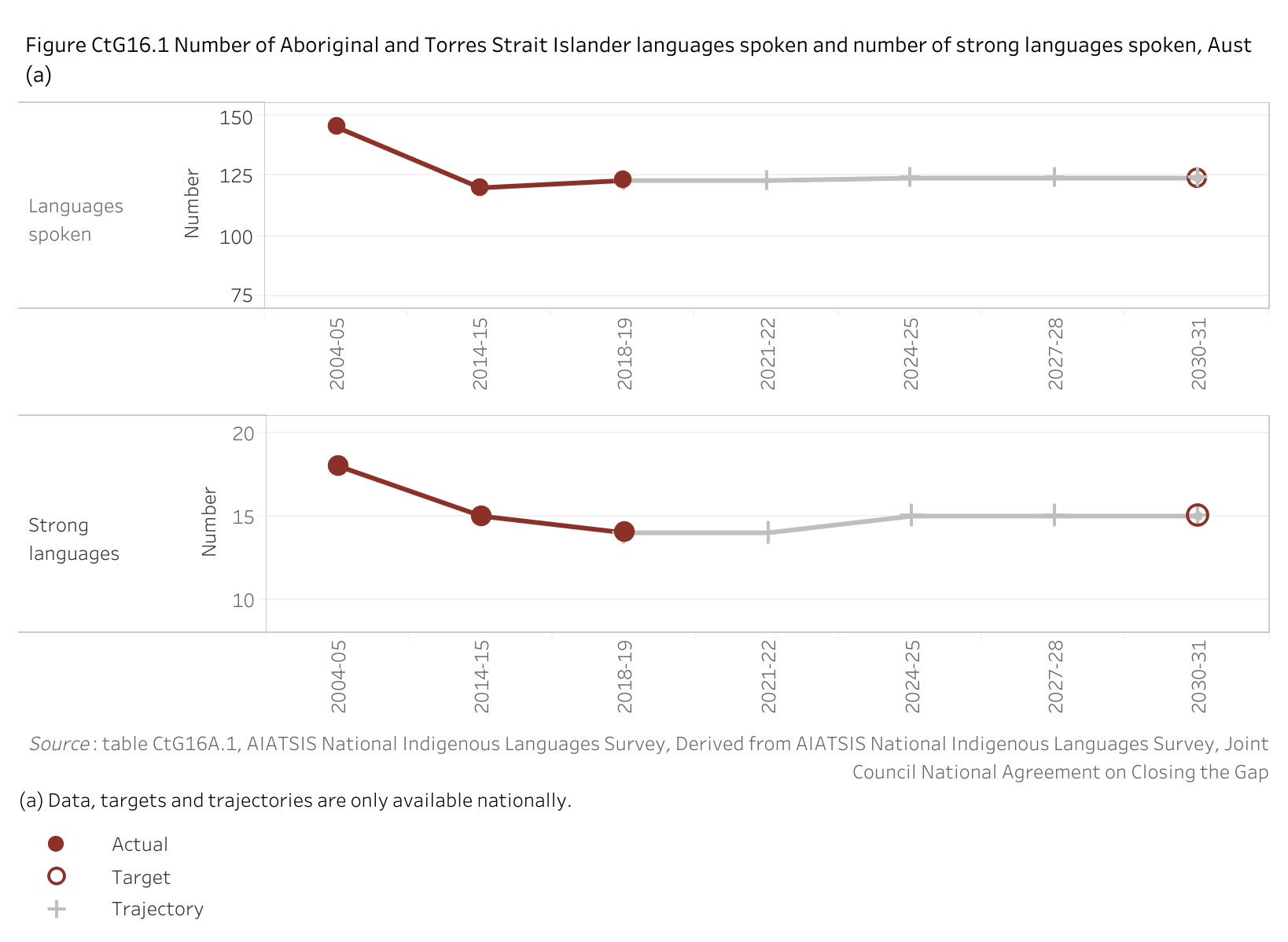Target 16
By 2031, there is a sustained increase in number and strength of Aboriginal and Torres Strait Islander languages being spoken.
Dashboard snapshot: The data below are the most recent at the time of preparing the July 2022 report. Please go to the dashboard to access the current data.
Nationally in 2018-19, there were 123 Aboriginal and Torres Strait Islander languages being spoken (with 14 considered strong) (figure CtG16.1).
There are no new data since the baseline year of 2018-19. Please see the How to interpret the data page for more information.
Target data specifications
Outcome: | Aboriginal and Torres Strait Islander cultures and languages are strong, supported and flourishing. |
|---|---|
Target: | By 2031, there is a sustained increase in number and strength of Aboriginal and Torres Strait Islander languages being spoken. |
Indicator: | The number and strength of Aboriginal and Torres Strait Islander languages being spoken. |
Measure: | This measure is defined as: a: The number of Aboriginal and Torres Strait Islander languages being spoken. b: The number of Aboriginal and Torres Strait Islander languages categorised as strong. |
Target established: | National Agreement on Closing the Gap July 2020 |
Latest dashboard update: | 23 June 2021 |
Indicator type: | Target |
Interpretation of change: | A high or increasing number is desirable. An increase from the baseline year is an improvement. |
Data source(s): | Name: National Indigenous Languages Surveys (NILS) Frequency: Periodic. National Indigenous Languages Surveys are conducted at irregular intervals: NILS1 in 2004-05, NILS2 in 2014-15 and NILS3 in 2018-19. There is currently no date set for future iterations of the NILS. Documentation (links): https://aiatsis.gov.au/research/current-projects/third-national-indigenous-languages-survey |
Data provider: | Provider name: Australian Institute of Aboriginal and Torres Strait Islander Studies (AIATSIS) Provider area: Languages |
Baseline year: | 2018-19 |
Target year: | 2030-31 |
Disaggregations: | Australia, by number of languages spoken currently Australia, by number of new languages spoken currently Australia, by number of strong languages Australia, by number of endangered languages (critically and severely endangered) Australia, by number of languages gaining speakers. |
Computation: | The NILS3 uses the following definitions: Strong language: the language is used by all age groups, including all children, and people in all age groups are fluent speakers. New language: Australian languages that have formed since 1788 from language contact between speakers of traditional languages with speakers of English and/or other languages. Critically endangered: the language is used mostly by the great-grandparental generation and older. Only people in the great-grandparental generation and older may remember some of the language and may not use it very often. Severely endangered: the language is mostly used by the grandparental generation and older. Only people in the grandparental generation and older may still understand the language. There is no overlap between 'Endangered languages' categories. In the 2018-19 AIATSIS, each language has been assigned to only one endangerment category based on two indicators: absolute numbers of speakers, and intergenerational transmission. Traditional languages: the term used to refer to languages spoken by Aboriginal and Torres Strait Islander people prior to colonisation, or the directly descended varieties spoken today. Individual traditional languages have individual names. |
Data quality considerations: | Although best available data have been used to produce the baseline, there are several factors needed to be considered when interpreting the baseline:
|
Future reporting: | Additional disaggregations required for future reporting: Languages by:
|
Supporting indicators
Driver
- Proportion of Aboriginal and Torres Strait Islander languages categorised as strong
- Number of Aboriginal and Torres Strait Islander languages being spoken
- Number and age profile of the speakers of Aboriginal and Torres Strait Islander languages
Including children
- Proportion of Aboriginal and Torres Strait Islander people who speak an Indigenous language
Contextual information
Material for download
- Cultures and languages are strong, supported and flourishing data tables (XLSX - 31 Kb)
- Cultures and languages are strong, supported and flourishing dataset (CSV - 16 Kb)
To assist with interpretation of the data provided (Excel data tables and CSV dataset) please refer to the target data specification (above) and the indicator data specifications (provided in each supporting indicator page – linked above).
